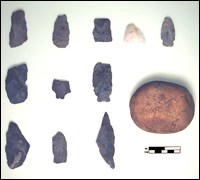
Richard Schlecht, copyright by Richard Schlecht 
Native Americans have had a presence in the Monocacy River area since the earliest occupation of North America. Diagnostic projectile points have been found along the forested river edge dating as early as the Paleo-Indian period (12,000-8,000 B.C.). Early human land use probably focused on foraging and exploitation of the lithic resources found in the river valley. During the Archaic period (8,000-1,200 B.C.) occupation of the Monocacy River Valley continued; however, habitation also eventually expanded into the valley floors, foothills and piedmont uplands. The environment gradually became warmer and drier during this period, resulting in a resurgence in grasslands. Culturally, the Archaic period is marked by an increase in territoriality. During the Woodland period (1,200 B.C. - A.D. 1600), Native American populations appear to have increased substantially. The Woodland period is also characterized by an increase in the size of individual settlements, as well as greater sociopolitical complexity and the emergence of agriculture. A total of eleven prehistoric sites have been recorded at Monocacy National Battlefield, representing occupations from the early Archaic to the late Woodland periods. |
Last updated: August 11, 2020
